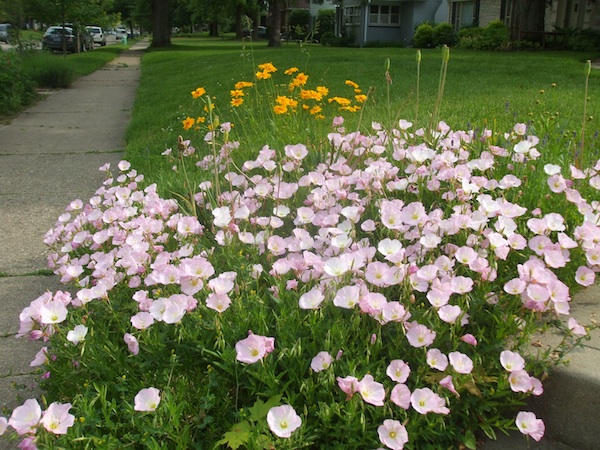
- Japanese honeysuckle vine smells heavenly, but it has escaped landscapes and rooted in natural areas, where it smothers native plants. This aggressive habit puts it on the invasive plant lists in Indiana, other states and the federal government. Photo courtesy of Invasive.org
Some perennials are attractive, vigorous growers. And those last two words are the reasons why I would not plant them in my yard.
These are the plants your neighbors, friends and family want to share because the perennials have done so well in their yards. These also can be found in garden centers and mailorder and online retailers, frequently described as vigorous growers. Don’t bother.
Here’s a sampler:
Evening primrose (Oenothera speciosa). This native plant forms huge colonies of quarter to 50-cent size, pretty pink flowers atop 12 to 18 inch tall stems. It gets its name because the flowers open at dusk. A popular cultivar is ‘Siskiyou Pink’. Alternative: ‘Bath’s Pink’ cheddar pinks (Dianthus gratianopolitanus).
Bishop’s goat weed or snow on the mountain (Aegopodium podagraria, A. p. ‘Variegatum’). There are solid green and variegated varieties. I planted the variegated type as a ground cover when I first started gardening. After a few years, I was pulling it out by the bucketsful. This plant, with lovely Queen Anne’s lace type flowers, does not know when to stop spreading. Alternative: bishop’s cap or barrenwort (Epimedium).
Bishop’s goat weed and evening primrose could be grown in a bed bounded by sidewalks, house or other hardscape.
Japanese honeysuckle vine (Lonicera japonica). A fast growing vine with fragrant, yellow-white flowers make this an attractive plants. And just as fast at it grows in your yard, it is taking hold in natural areas throughout Indiana and elsewhere. It’s vigor has earned it a spot on the state and federal lists of invasive species. Alternatives: ‘Major Wheeler’, ‘John Clayon’ (L. sempervirens); ‘Goldflame’ (L. x heckrottii); ‘Serotina’, Peaches and Cream (L. periclymenum).

Evening primrose can be a thug in the garden, overtaking neighborhing plants. © Jo Ellen Meyers Sharp
Sweet autumn clematis (C. terniflora, C. paniculata) is another fast growing vine that self-sows like crazy. Alternatives: honeysuckles (see above); other clematis; late blooming annuals vines, such as cardinal vine (Ipomoea quamoclit).
